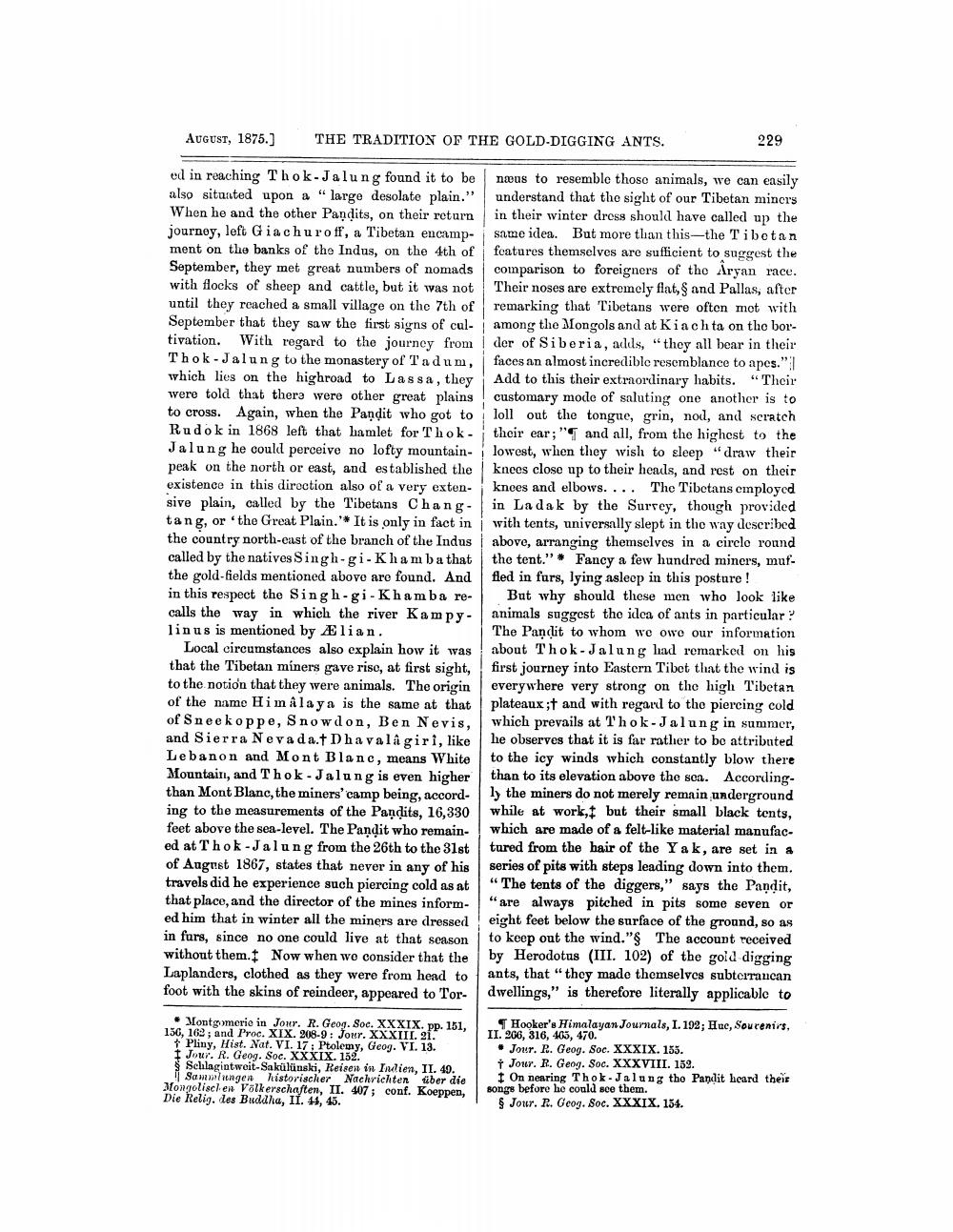________________
AUGUST, 1875.)
THE TRADITION OF THE GOLD DIGGING ANTS.
229
ed in reaching Thok-Jalung found it to be næus to resemble thoso animals, we can easily also situated upon a "large desolate plain." understand that the sight of our Tibetan miners When he and the other Pandits, on their return in their winter dress should have called up the journoy, left Giachuro ff, a Tibetan encamp- same idea. But more than this-the Tibetan ment on the banks of the Indus, on the 4th of foatures themselves are suflicient to suggest the September, they met great numbers of nomads comparison to foreigners of the Aryan race. with flocks of sheep and cattle, but it was not Their noses are extremely flat, & and Pallas, after until they reached a small village on the 7th of remarking that Tibetans were often mot with September that they saw the first signs of cal. among the Mongols and at Kiach ta on the bortivation. With regard to the journey from der of Siberia, adds, "they all bear in their Thok - Jalung to the monastery of Tadum, i faces an almost incredible resemblance to apes." which lies on the highroad to Lassa, they Add to this their extraordinary habits. "Their were told that there were other great plains ! customary mode of saluting one another is to to cross. Again, when the Pandit who got to loll out the tongue, grin, nou, and scratch Rudok in 1868 left that hamlet for Thok. | their ear;" and all, from the highest to the Jalung he could perceive no lofty mountain- lowest, when they wish to sleep "draw their peak on the north or east, and established the knees close up to their heals, and rest on their existence in this direction also of a very exten- knees and elbows. ... The Tibetans employed sive plain, called by the Tibetans Chang in Ladak by the Surrey, though provided tang, or the Great Plain.' It is only in fact in with tents, universally slept in the way described the country north-east of the branch of the Indus above, arranging themselves in a circlo round called by the natives Singh-gi-Khamba that the tent." Fancy a few hundred miners, mufthe gold fields mentioned above are found. And fled in furs, lying asleep in this posture ! in this respect the Singh-gi-Khamba re- But why should these men who look like calls the way in which the river Kampy- | animals suggest the idea of ants in particular linus is mentioned by Ælian.
The Pandit to whom we owo our information Local circumstances also explain how it was about Thok-Jalung lad remarked on his that the Tibetan miners gave rise, at first sight, first journey into Eastern Tibet that the wind is to the notion that they were animals. The origin everywhere very strong on the high Tibetan of the name Himalaya is the same at that! plateaux;t and with regard to the piercing cold of Sneekoppe, Snowdon, Ben Nevis, which prevails at Thok-Jalung in summer, and Sierra Nevada. Dhavalîgiri, like he observes that it is far rather to be attributed Lebanon and Mont Blanc, means White to the icy winds which constantly blow there Mountain, and Thok - Jalung is even higher than to its elevation above the son. Accordingthan Mont Blanc, the miners' camp being, accord- by the miners do not merely remain underground ing to the measurements of the Pandits, 16,330 while at work, t but their small black tents, feet above the sea level. The Pandit who remain- which are made of a felt-like material manufaced at Thok-Jalung from the 26th to the 31st tured from the hair of the Yak, are set in a of August 1867, states that never in any of his series of pits with steps leading down into them. travels did he experience such piercing cold as at "The tents of the diggers," says the Pandit, that place, and the director of the mines inform- "are always pitched in pits some seven or ed him that in winter all the miners are dressed eight feet below the surface of the ground, so as in furs, since no one could live at that season to keep out the wind." The account received without them. Now when we consider that the by Herodotus (III. 102) of the gold digging Laplanders, clothed as they were from head to ants, that "they made themselves subterrancan foot with the skins of reindeer, appoared to Tor- dwellings," is therefore literally applicable to
Montgomerie in Jour. R. Geog. Soc. XXXIX. pp. 151, 156, 169; and Proc. XIX. 208-9 : Jour. XXXIII. 21.
Pliny, Hist. Nat. VI. 17: Ptolemy, Geog. VI. 13. Jour. R. Geog. Soc. XXXIX. 152. Schlagintweit-Sakülünski, Reisen in Imien, II. 49.
Sammlungen historischer Nachrichten siber die Mongolischen Völkerschaften, II. 407; conf. Koeppen, Die Relig. des Buddha, II. 45, 45.
Hooker's Himalayan Journals, I. 192; Hac, Sourenirs, II. 206, 316, 465, 470.
• Jour. P. Geog. Soc. XXXIX. 153. † Jour. R. Geog. Soc. XXXVIII. 159.
1 On nearing Thok-Jalung tho Pandit heard their songs before he could see them.
Jour. P. Geog. Soc. XXXIX. 154.




